Kashyapa Shilpa-shastra (study)
by K. Vidyuta | 2019 | 33,520 words
This page relates ‘Measurement for the Storeys of the Gopuras’ of the study on the Kashyapa Shilpa-shastra (in English) with special reference to the characteristics of Prakara (temple-components), Mandapa (pavilions) and Gopura (gate-house). The Silpa-Sastras refers to the ancient Indian science of arts and crafts, such as sculpture, architecture and iconography. This study demonstrates the correlatation between ancient Indian monuments (such as temples and sculptures) and the variety of Sanskrit scriptures dealing with their construction.
5. Measurement for the Storeys of the Gopuras
[Note: The verses from this section onwards are quoted from the Aṃśumatkāśyapa as the Kāśyapa Śilpaśāstra version is incomplete.]
The storeys of the gopuras are to be constructed on the basis of the measure of the paṅktis. For this purpose, the breadth and height of the gopuras must range from 3 to 19 paṅktis.
For instance, if the breadth measures 2 paṅktis then the length will also be of the same paṅkti measure (44. 43cd-4):
guṇabhaktisamārabhya yāvadekonaviṃśatiḥ ||
tāvatpaṃktistu vistāre evamevaṃ prakalpayet |
yāvaddvipaṃktayorcyāse tāvadevāyapaṃktayaḥ ||
(i). One-storeyed Gopura
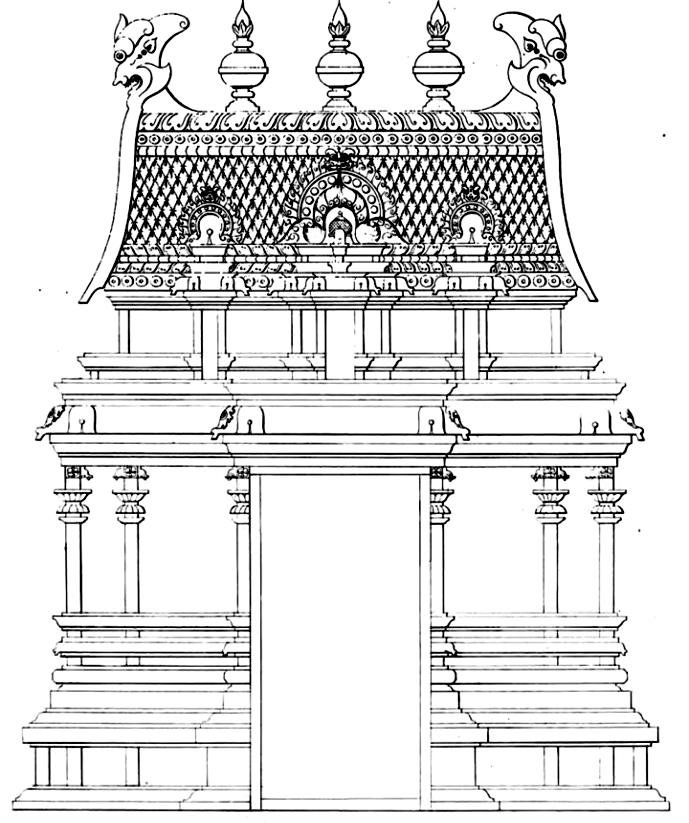 If the extent of the gopura is divided into 5 parts, then 3 parts of it is the measure of the garbhagṛha and the remaining 2 parts constitute the measure of the wall; or if the upper end of the gopura is half hasta then the remaining parts from the breadth of paṅkti.
If the extent of the gopura is divided into 5 parts, then 3 parts of it is the measure of the garbhagṛha and the remaining 2 parts constitute the measure of the wall; or if the upper end of the gopura is half hasta then the remaining parts from the breadth of paṅkti.
Surrounding this, walls of the measure of the breadth of the paṅkti are to be constructed and thus the measure for one-storeyed gopura is stated (44. 45-7ab):
vistāre pañcabhāge tu guṇāṃśaṃ garbhagehakam |
śeṣaṃ kuḍyaviśālaṃ syāt tārārdhaṃ vāgrahastakam ||
śeṣaṃ bhaktiviśālaṃ syādekabhūmau dvijottama |
paritaḥ kuḍyavistāraṃ mānenaiva prakalpayet ||
evamekatalaṃ khyātaṃ ... ... ...|
(ii). Two-storeyed Gopura[1]
.jpg) (a) Square-based:
(a) Square-based:
For two-storeyed gopura, if the breadth is in 5 parts so is its length. 2 parts of the breadth are the garbhagṛha, 1½ parts are the breadth of the wall, the karṇakūṭa (side tower) is of 1 part and the length of the koṣṭhas (niches) is of 3 parts measure.
The hārāntara[2] must be constructed of 1 part measure (44. 47cd-9ab):
vistāre pañcabhāgaṃ syādāyāme'pi tathaiva ca ||
dvyaṃśāṃśaṃ garbhagehaṃ tu sārdhāṃśaṃ kuḍyavistṛtam |
ekāṃśaṃ karṇakūṭaṃ syāt guṇāṃśaṃ koṣṭha dīrghakam ||
hārāntaraṃ śivāṃśaṃ syāt kalpayedevameva vā |
(b) Rectangular:
If the breadth of the gopura is divided into 7 parts the length is divided into 9 parts.
Based on the divisions of the breadth of the gopura, the garbhagṛha shall be of 4 parts; the width of the wall is 1½ parts; the karṇkūṭa measures 1 part; the length of the śālā is of 3 parts and the hārāntara is one part of the breadth (44. 49cd-51ab):
vistāraṃ saptabhāgaṃ syāt navabhāgaṃ tadāyatam ||
yugāṃśaṃ garbhagehaṃ tu sārdhāṃśaṃ kuḍyavistṛtam |
karṇakūṭaṃ tu tāraṃśaṃ śālādīrghaṃ guṇāṃśakam ||
hārāntaraṃ tadaṃśena vistāre caivameva vā |
Otherwise, the length of the śālā is 5 parts the length of the gopura; the inner space of the hāra and the measure of the kūṭa is of 1 part; the interior length of the kūṭa is also the same and the remaining part is the measure of the hāra that it connects. Half the measure of the hāra is the measure of the bhadra and the bhadra pañjara.
These are the measures mandated for the two-storeyed gopuras (44. 51cd-3):
śālādīrghaṃ tu pañcāṃśaṃ āyāmaṃ tu prakalpayet ||
hārāntaraṃ ca kūṭaṃ ca ekaikāṃśena kalpayet |
kūṭāntarasamāyāmaṃ śeṣaṃ hārānvitaṃ bhavet ||
hārāntarārdhamānena bhadraṃ vā bhadrapaṃjaram |
dvitalaṃ hyevamākhyātaṃ ... ... ... ||
(iii). Three-storeyed Gopura
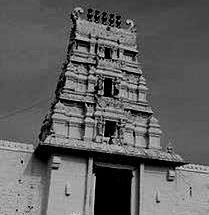 (a) Square:
(a) Square:
If the breadth is divided into 12 parts, so is the length too; among this the garbhagṛha is of 3 parts and the gṛhapiṇḍikā (basement of the gopura or any building) is of 1 part. The alinda is of 1 part; the breadth of the hāra is of 1 part, so is the karṇa-kūṭa and the length of the śālā is of 3 parts. The pañjara's breadth is of 1 part measure and the hārāntara is also 1 part.
Thus the first storey is designed; the remaining two storeys must be constructed as enjoined earlier (44. 54-6):
ravyaṃśaṃ[3] vibhajedvyāsaṃ āyāmaṃ ca tathā bhavet |
garbhagehaṃ guṇāṃśaṃ syādaṃśena gṛhapiṇḍikā ||
alindaṃ caikabhāgena hāravyāsaṃ śivāṃśakam |
karṇakūṭaṃ śivāṃśena śālādīrghaṃ guṇāṃśakam ||
ekāṃśaṃ pañjaravyāsaṃ tamekāṃśaṃ hāramantaram |
kalpyaivamādibhūmiṃ tu dvitalaṃ pūrvavadviduḥ ||
Alternative set of measures are also given for the three-storeyed gopuras. If the breadth and length of the dvārasobhā is divided into 11 parts; 3 parts of it is that of the garbhagṛha; 1 part is gṛhapiṇḍi; the alinda and the hāra are also to be constructed of the same measure. One part of alinda is the measure for the connecting path from the wall to the garbhagṛha. The length of the koṣṭha is 5 parts the length of the gopura and the remaining two storeys are constructed as stated earlier.
Thus the three-storeyed gopuras are constructed (XLIV. 57-60):
athavānyaprakāreṇa tritalaṃ śṛṇu suvrata |
dvāraśobhaṃ tu vistāraṃ rudrāṃśaṃ tu tadāyatam ||
guṇāṃśaṃ garbhagehaṃ tu gṛhapiṇḍyaṃśamucyate |
alindaṃ tatsamaṃ khyātaṃ hāraṃ bhāgena kalpayet ||
alindāṃśaṃ tu kuḍyaṃ vā garbhagehānvitaṃ tu vā |
āyāme pañcabhāgena koṣṭhadīrghaṃ prakalpayet ||
śeṣaṃ pūrvavaduddiṣṭaṃ dvitīyaṃ dvitaloktavat |
tritalaṃ hyevamākhyātaṃ ... ... ... ||
(iv). Four-storeyed Gopura[4]
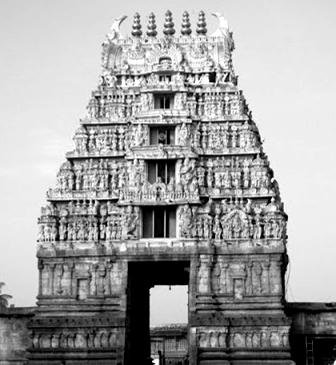 (a) Square:
(a) Square:
The measurements for the first storey or the base floor of the gopura is given as If the breadth of the gopura is divided into 10 parts, then the length is also of the same number of divisions. Of these divisions the garbhagṛha is of 3 parts and the extent of the wall is of 1½ parts.
Alinda and the breadth of the hāra is of 1 part each; the pañjara and karṇakūṭa must be constructed with a measure of 1 part each; the kūṭa must be of equal breadth and length and the remaining measure is that of the connecting hāra (44. 61-3ab):
vistāre tu daśāṃśe tu tadvadāyāmapaṅktayaḥ |
garbhagehaṃ tribhāgādi sārdhāṃśaṃ kuḍyavistṛtam ||
alindaṃ śivabhāgena hāravyāsaṃ tathaiva ca |
pañjaraṃ karṇakūṭaṃ ca tvekaikāṃśena kalpayet ||
kūṭatārasamāyāmaṃ śeṣaṃ hārāntarānvitam |
Of the 10 parts length of the gopura, the śālā is of 4 parts, hārāntara is of 1½ parts; the remaining measures of the different components of the gopura are as prescribed earlier. The storeys above it also, are to be constructed as instructed earlier.
(b) Rectangular:
Alternative measurement is if the breadth of the gopura is divided into 10 parts, then the length is of 12 parts. The śālās in the front and back are to be built with the measure of 5 parts each and the remaining measure must be used to design the components.
Thus the four-storeyed gopuras are constructed (44. 63cd-5):
śālāyāme tu vedāṃśe ardhāṃśaṃ hāramantaram ||
ādibhūmyevamākhyātaṃ ūrdhvaṃ pūrvavadācaret |
vistāre tu daśāṃśe tu bhānvaṃśaṃ tu tadāyatam ||
pūrve pare ca śālāyāṃ pañcabhāgena kalpayet |
śeṣaṃ pūrvavaduddiṣṭaṃ caturbhūmimidaṃ param ||
(v). Five-storeyed Gopura[5]
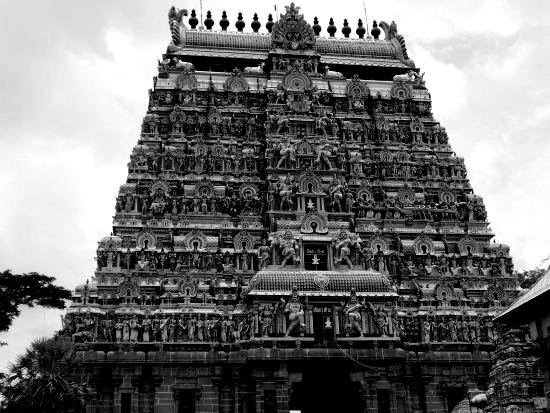 (a) Square:
(a) Square:
If the breadth of the gopura is of 11 parts, then so is its length The śālās to its sides, front and back are to be of 5 parts in length. The pañjara and the kūṭa are of 1 part in extent. The hārāntara must be built of 1 part measure and so these constitute the first storey of this gopura.
The next upper floors must be designed as specified before (44. 66-8ab)[6] :
tāramekādaśāṃśaṃ tu āyāmaṃ ca tathaiva ca |
pūrve pare ca pārśve ca śālā pañcāṃśamāyatam ||
ekāṃśaṃ pañjaravyāsaṃ kūṭa vyāsaṃ śivāṃśakam |
hārāntaraṃ tathāśaṃ ca kalpyevaṃ prathamaṃ talam ||
tasyordhvabhūmayaḥ sarvāḥ pūrvavatparikalpayet |
(b) Rectangular:
Alternatively, if the breadth of the gopura is of 11 parts, then it length is in 13 parts of these, the garbhagṛha constitutes 3 parts and 2 parts is the measure for the extent of the wall.
The alinda and the hāra are built in 1 part measure. Other constituent parts like the kūṭa and koṣṭha must be constructed as described earlier and these are the rules for designing a five-storeyed gopura (44. 68cd-70):
tāramekādaśāṃśe tu taddīrghaṃ tu trayodaśam ||
guṇāṃśaṃ garbhagehaṃ ca dvibhāgaṃ bhittivistṛtam |
alindaṃ caikabhāgena hārabhāgena kalpayet ||
kūṭakoṣṭhādi sarvāṃgaṃ prāgivaiva prakalpayet |
paṃcabhūmessamākhyātaṃ ... ... ... ||
(vi). Six-storeyed Gopura
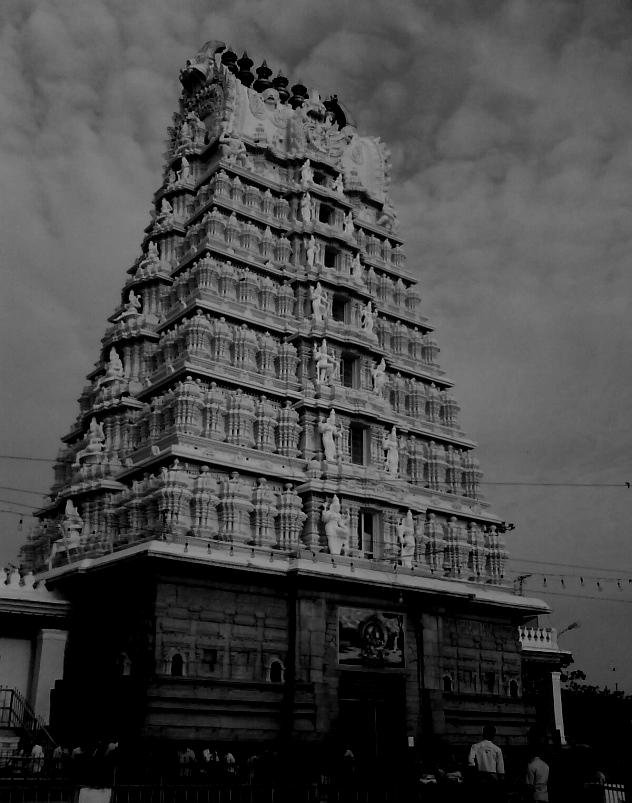 The gopura that has a breadth of 12 parts also has a length of 14 parts of which 4 parts constitute the garbhagṛha with 2 paṅktis; alinda and hāra are of 1 part each. The śālās on the sides are of 4 parts in measure and those in the front and back are 6 parts each. The hārāntara must be of 1 part and the pañjara with the kūṭa must be of 1 part.
The gopura that has a breadth of 12 parts also has a length of 14 parts of which 4 parts constitute the garbhagṛha with 2 paṅktis; alinda and hāra are of 1 part each. The śālās on the sides are of 4 parts in measure and those in the front and back are 6 parts each. The hārāntara must be of 1 part and the pañjara with the kūṭa must be of 1 part.
The remaining storeys must be constructed as shown earlier and this is the six-storeyed gopura (44. 71-3)[7] :
tāre tu dvādaśāṃśe tu manvaṃśe tu tadāyatam |
yugāṃśaṃ garbhagehaṃ tu dvibhāgaṃ bhaktivistṛtam ||
alindaṃ bhāgayā kalpya hāraṃ bhāgena kalpayet |
pārśvaśālā tu vedāṃśaṃ ṣaḍaṃśaṃ mukhapṛṣṭhayoḥ ||
hārāntaraṃ śivāṃśaṃ syāt vyomaṃ pañjarakūṭayoḥ |
śeṣaṃ pūrvavaduddiṣṭaṃ rasabhūmyevameva tu ||
(vii). Seven storeyed Gopura[8]
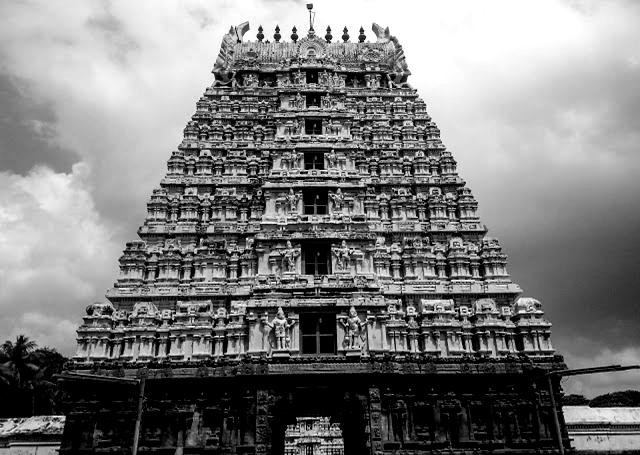 In case of the gopura having breadth of 13 parts, then so is its length; of this measure the garbhagṛha is of 5 parts and the gṛhapiṇḍī is of 2 parts.
In case of the gopura having breadth of 13 parts, then so is its length; of this measure the garbhagṛha is of 5 parts and the gṛhapiṇḍī is of 2 parts.
The alinda and the khaṇḍa harmya is of 1 part; the length of the koṣṭha is of 5 parts and all the other components like the pañjara, kūṭa, the hārāntara, must be of 1 part each (44. 74-6ab):
trayodaśāṃśe viṣkambhe āyāme ca tathaiva hi |
bhūtāṃśaṃ garbhagehaṃ tu gṛhapiṇḍī dvibhāgayā ||
alindaṃ tu śivāṃśena khaṇḍaharmyaṃ śivāṃśakam |
koṣṭhāyāmaṃ tu bhūtāṃśaṃ sarvatrāṃśena pañjaram ||
kūṭamaṃśena kartavyaṃ hārāntaraṃ tathaiva hi |
Alternatively, if the breadth of the gopura is of 13 parts measure, then the length of it must be 15 parts. In front of all the entrances a mahāśālā of 7 parts must be constructed and those on the sides must be of 5 parts measure. The remaining parts of the measure must be taken up to design the other ornamental components as previously described.
This is the measurement for the seven storeyed gopura or the mahāgopura (44. 76cd-8):
athavā trayodaśaṃtāraṃ āyāmaṃ tu tripañcakam ||
mukhe mukhe mahāśālā saptāṃśena prakalpayet |
pañcabhāgena kartavyaṃ kartavyaṃ pārśvadīrghakam ||
śeṣaṃ pūrvavaduddiṣṭaṃ sarvālaṃkārasaṃyutam |
saptabhūmisamākhyātā tanmahāgopuraṃ bhavet ||
Furthermore, the text states that the gopuras must be constructed along with or without alindas and if it is constructed without alindas then the gopuras must be endowed with walls and garbhagṛha. Also, the garbhagṛha must be built along with an alinda.
Thus the first storey of the gopura must be designed and the remaining upper 6 storeys of the seven storeyed gopura have to be erected as described earlier (44. 79-81ab):
sālindaṃ vā vinālindaṃ kalpayetkalpavittamaḥ |
vinālindaṃ kṛtaṃ cettu kuḍyagarbhagṛhaṃ tu vā ||
alindāṃśaṃ tu saṃyojya kārayettu dvijottamaḥ |
ādibhūmyaivamākhyātamūrdhvaṃ ṣaṭtalavadbhavet ||
saptabhūmisamākhyātaṃ ... ... ... |
Footnotes and references:
[1]:
The verses of this section, in all the available editions of the Kāśyapa Śilpaśāstra seem to be erroneous, as the calculation does not tally with the description.
[3]:
Śrī Kāśyapa Śilpaśā stram, T anjore, 2016, p. 517.
[5]:
Photo courtesy: Naṭarajar temple, Chidambaram.
[6]:
The information in these verses, in all the editions of the Kāśyapa Śilpaśāstra seem to be erroneous, for the calculation does not tally with the description.
[7]:
The information in these verses does not tally with the calculation. All the editions of Kāśyapa Śilpaśāstra are not clear in this regard. Photo Courtsey: Chāmuṇdīśvarī temple, Mysore.
[8]:
Photo courtesy: Jalakanteśvara Temple, Vellore.
